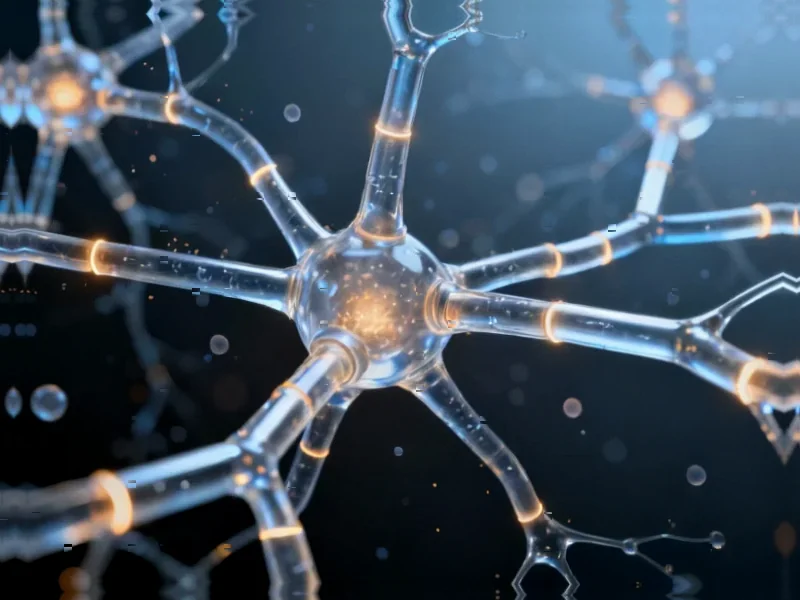According to ScienceAlert, researchers from Cedars-Sinai Medical Center have developed engineered ‘young’ immune cells that reversed Alzheimer’s symptoms in mice by improving brain function and memory. The team used human induced pluripotent stem cells to create mononuclear phagocytes, which normally clean up cellular waste but become less effective with age. Treated mice showed improved performance on memory tests, developed healthier microglia in their brains, and exhibited increased numbers of mossy cells crucial for hippocampal function. Interestingly, the engineered cells didn’t reach the animals’ brains directly but appeared to work through secreted factors like anti-aging proteins or extracellular vesicles. The findings, while primarily effective in aging mice rather than those specifically modeling Alzheimer’s, represent a promising new therapeutic approach that could overcome limitations of current treatments like blood plasma transfusions.
The Cellular Cleanup System That Fails With Age
The research highlights a fundamental biological process that deteriorates in neurodegenerative diseases: cellular waste management. Mononuclear phagocytes function as the body’s janitorial service, clearing protein aggregates and cellular debris that accumulate in aging brains. What makes this approach particularly insightful is that it doesn’t target the amyloid plaques directly – instead, it addresses the underlying clearance mechanism that becomes inefficient with age. This represents a shift from traditional Alzheimer’s research that often focuses on removing specific pathological proteins. The study’s methodology suggests that restoring youthful cellular function might be more effective than targeting individual disease markers.
The Surprising Indirect Mechanism and Its Advantages
Perhaps the most intriguing aspect of this research is that the beneficial effects occurred without the engineered cells actually entering the brain. This suggests the treatment works through secreted factors – what researchers call the “bystander effect.” This mechanism could actually be advantageous for clinical translation because it avoids the blood-brain barrier challenge that plagues many neurological therapies. If the therapeutic benefit comes from circulating factors rather than the cells themselves, it opens possibilities for developing less invasive treatments. The Cedars-Sinai team’s approach of using induced pluripotent stem cells also means treatments could potentially be personalized using a patient’s own cells, reducing immune rejection risks.
The Long Road From Mouse Models to Human Treatment
While the results are promising, the translation to human Alzheimer’s treatment faces significant hurdles. The study showed limited effects in mice specifically engineered for Alzheimer’s pathology compared to normal aging mice, suggesting this approach might be more effective for age-related cognitive decline than advanced Alzheimer’s. Additionally, the treatment didn’t clear existing amyloid-beta plaques – a hallmark of Alzheimer’s pathology. This indicates that such cellular therapies might work best as preventive measures or early interventions rather than treatments for established disease. Previous research on young blood factors has shown similar challenges in translating mouse results to human patients, highlighting the complexity of age-related cognitive disorders.
Broader Implications for Age-Related Diseases
This research extends beyond Alzheimer’s to the fundamental biology of aging. The approach of rejuvenating the immune system’s cleanup capacity could have applications across multiple age-related conditions where cellular waste accumulation and inflammation play roles. Parkinson’s disease, other neurodegenerative disorders, and even general age-related cognitive decline might benefit from similar strategies. The findings align with growing evidence that immune system aging contributes significantly to overall organismal aging. As research in this area progresses, we might see a new class of therapies focused on restoring youthful cellular functions rather than targeting specific disease pathways.
Where This Research Leads Next
The immediate next steps will involve identifying the specific factors secreted by these young immune cells that produce the cognitive benefits. Understanding whether extracellular vesicles, specific proteins, or other signaling molecules are responsible could lead to more targeted therapies. Researchers will also need to determine optimal timing for intervention and whether combination approaches with existing Alzheimer’s treatments might be more effective. The limited impact on established Alzheimer’s pathology suggests this approach might work best as part of a multi-pronged strategy. As the population ages and Alzheimer’s cases increase, such innovative approaches that address fundamental aging processes represent crucial new directions in the fight against neurodegenerative diseases.




